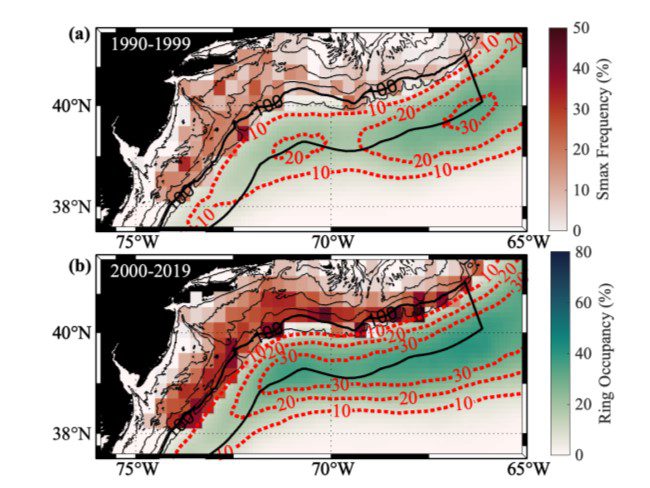Silver, A., Gangopadhyay, A., Gawarkiewicz, G., Fratantoni, P., & Clark, J., 2023. Increased Gulf Stream warm core ring formations contributes to an observed increase in salinity maximum intrusions on the Northeast Shelf. Scientific Reports, 13(1), 7538. https://doi.org/10.1038/s41598-023-34494-0

(Image provided by Adrienne Silver)
We present observational evidence of a significant increase in Salinity Maximum Intrusions in the Northeast US Shelf waters in the years following 2000. This increase is subsequent to and influenced by a previously observed regime-shift in the annual formation rate for Gulf Stream Warm Core Rings, which are relatively more saline than the shelf waters. Specifically, mid-depth salinity maximum intrusions, a cross-shelf exchange process, has shown a quadrupling in frequency on the shelf after the year 2000. This increase in intrusion frequency can be linked to a similar increase in Warm Core Ring occupancy footprint along the offshore edge of the shelf-break which has greatly increased the abundance of warm salty water within the Slope Sea. The increased ring occupancy footprint along the shelf follows from the near doubling in annual Warm Core Ring formation rate from the Gulf Stream. The above figure shows the Salinity Maximum Intrusion frequency compared to the ring occupancy for the two regimes (a) Regime 1 (1990–1999) and (b) Regime 2 (2000–2019). The red shading over the shelf shows the Salinity Maximum Intrusion frequency within 0.3 by 0.3 degree bins from EcoMon Data and the green–blue shading within the Slope Sea shows the percentage of the year each region was occupied by Warm Core Rings with the 10, 20, and 30% occupancy contours plotted in red dotted lines.
